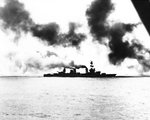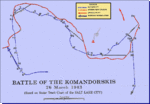syscom3
Pacific Historian
Not many people know much about this sea battle fought in the wretched seas in the western Aleutian islands. The USN narrowly escaped destruction, so all-in-all, it was a "draw" in every sense of the word. Even still "ALL HAIL TO THE BLUE JACKETS WHO SAVED THE DAY!!!"
The Battle of the Komandorski Islands was one of the most unusual engagements of World War II. It was a naval battle which took place on 27 March 1943 in the North Pacific area of the Pacific Ocean, near the Komandorski Islands.
When the United States became aware of Japanese plans to send a supply convoy to garrisons on the Aleutian Islands, U.S. Navy ships commanded by Rear Admiral Charles McMorris were dispatched to intercept. The U.S. fleet consisted of the heavy cruiser Salt Lake City, the old light cruiser Richmond and the destroyers Coghlan, Bailey, Dale and Monaghan.
Unknown to the Americans, the Japanese had chosen to escort their convoy with two heavy cruisers, two light cruisers, and four destroyers commanded by Vice Admiral Boshiro Hosogaya. On the morning of 27 March, the Japanese convoy was intercepted by the U.S. picket line and combat ensued. Because of the remote location of the battle and chance encounter on open ocean, neither fleet had air or submarine assistance, making this the only engagement exclusively between surface ships in the Pacific Theatre, and the last pure gunnery duel in American naval history.
Battle
Mistakenly believing that the fight would be easy, the American warships formed up and closed the range. Two transports fled for safety as the Japanese warships turned to engage. The American group was outgunned and outnumbered but pressed on and made a course change in hopes of getting a shot at the transports before their escorts could intervene. There was also a possibility that the Japanese would split their force and that Salt Lake City and Richmond could tackle a portion of them on more equal terms.
The opposing cruisers simultaneously opened fire at a range of nearly ten miles (18 km). The ensuing battle was a retiring action on the part of the Americans since the Japanese foiled their attempt to get to the auxiliaries. Salt Lake City received most of the attention and soon received two hits, one of them amidships, mortally wounding two men, but she responded with very accurate fire. Her rudder stops were carried away, limiting her to 10 degree course changes. Another hit flooded forward compartments. Under cover of a thick smoke screen and aggressive torpedo attacks by the destroyers, the American cruisers were able to make an evasive turn, which for a while allowed the range to open. Salt Lake City soon began taking hits again, and her boiler fires died one by one. Salt water had entered the fuel oil feed lines. There was now cause for grave concern; she lay dead in the water, and the Japanese ships were closing fast. However, she was hidden in the smoke, and the enemy was not aware of her plight.
The destroyers charged the Japanese cruisers and began to draw the fire away from the damaged Salt Lake City. Bailey suffered two 8 inch hits while launching a spread of five torpedoes at long range. In the meantime, Salt Lake City engineers purged the fuel lines and fired the boilers. With fresh oil supplying the fires, she built up steam and gained headway. Suddenly, the Japanese began to withdraw, because they were fast exhausting their ammunition. They did not suspect that the Americans were in far worse shape in terms of both ammunition and fuel.
Outcome
Although the Japanese force outnumbered the U.S. group by two to one, the engagement was tactically inconclusive. Both sides suffered damage, with the U.S. force not being as badly hurt by the superior firepower of the Japanese as could have been the case. When the Japanese force was poised for victory, Admiral Hosogaya—not realizing the heavy damage his ships had inflicted on Salt Lake City, and fearing American air forces were en route—chose to retire without delivering a knockout blow. Withdrawal led to a strategic defeat for the Japanese because it ended their attempts to resupply their Aleutian garrisons by surface, leaving only submarines for resupply runs.
Hosogaya was retired from service after the battle.
The picture above is of the heavy cruiser "USS Salt Lake City".



